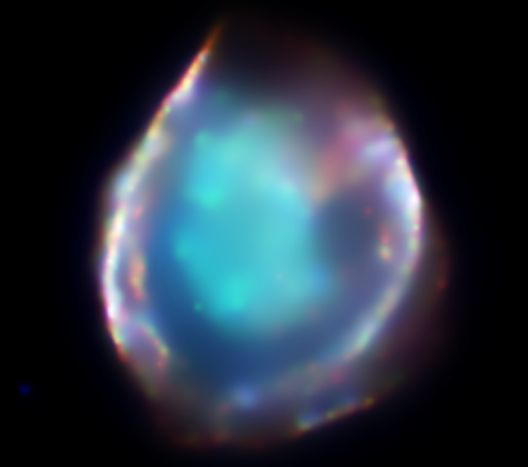
|
Explanation: Large, massive stars end their furious lives in spectacular supernova explosions -- but small, low mass stars may encounter a similar fate. In fact, instead of simply cooling off and quietly fading away, some white dwarf stars in binary star systems are thought to draw enough mass from their companions to become unstable, triggering a nuclear detonation. The resulting standard candle stellar explosion is classified as a Type Ia supernova and perhaps the best example yet of the aftermath is this expanding cloud of shocked stellar debris, DEM L71, in the nearby Large Magellanic Cloud. The sharp false-color x-ray image from the orbiting Chandra Observatory shows the predicted bright edges of the outer blast wave shock region and the x-ray glow of an inner region of reverse shock heated gas. Based on the Chandra data, estimates for the composition and total mass of expanding gas strongly suggest that this is all that remains of a white dwarf star. Light from this small star's self-destructive explosion would have first reached Earth several thousand years ago.
|
January February March April May June July August September October November December |
| |||||||||||||||||||||||||||||||||||||||||||||||||||||||
NASA Web Site Statements, Warnings, and Disclaimers
NASA Official: Jay Norris. Specific rights apply.
A service of: LHEA at NASA / GSFC
& Michigan Tech. U.
Based on Astronomy Picture
Of the Day
Publications with keywords: supernova remnant - white dwarf
Publications with words: supernova remnant - white dwarf
See also:
- APOD: 2025 October 1 Á NGC 6960: The Witchs Broom Nebula
- APOD: 2025 June 9 Á Between Scylla and Charybdis: A Double Cosmic Discovery
- Supernova Remnant Cassiopeia A
- APOD: 2025 January 8 Á Supernova Remnants Big and Small
- APOD: 2024 September 18 Á The Mermaid Nebula Supernova Remnant
- APOD: 2024 April 16 Á Filaments of the Vela Supernova Remnant
- APOD: 2024 April 3 Á Unusual Nebula Pa 30
